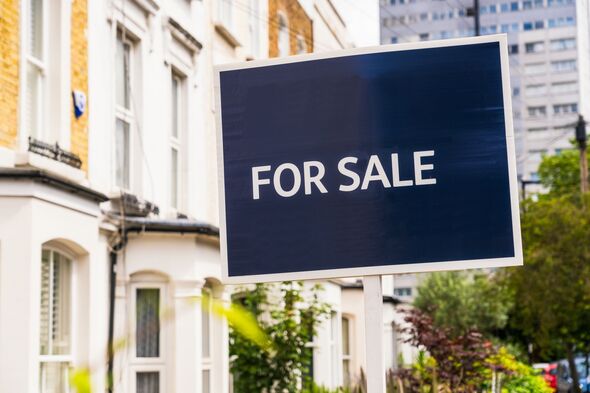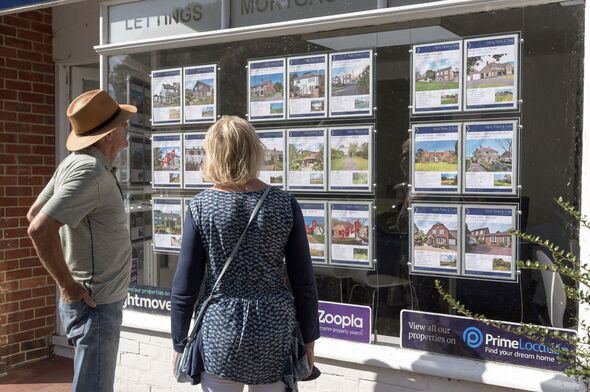
House prices rise fastest for this one property type as regional demand varys ‘hugely’ (Image: Getty)
Prices for smaller homes such as flats have been increasing at a faster rate than bigger properties amid affordability constraints, according to a major bank.
Halifax said there has been a switch in demand, reversing the “race for space” seen during the coronavirus pandemic when buyers were searching for bigger homes.
In the year to February, the latest Halifax House Price Index indicated that the average price of a flat increased by 2.7 percent, while the average terraced property value rose by 2.6 percent, Halifax said.
Meanwhile, prices for semi-detached and detached homes saw more modest increases of 1.7 percent and two percent respectively.
Regionally, Scotland led the way with a robust 5.9 percent growth in flat prices over the previous year, as reported by Halifax.

Halifax said there has been a switch in demand (Image: Getty)
Yorkshire and the Humber was the only English region to record a fall in prices for flats over the past year, with a decrease of 2.9 percent. The region also recorded the biggest increase in detached house prices over the past year, climbing by five percent.
At a national level, Halifax research found annual property price growth jumped by 1.9 percent in February this year, having plunged as low as -4.1 percent in October 2023.
In cash terms, prices are up by £5,318 over the last year and are only £7,801 below the peak recorded in August 2022.
Despite the challenging economic environment, prices remain 19.9 percent (£47,573) above pre-pandemic levels. By comparison, in the four years prior to March 2020, they rose by just 13.4 percent (£28,027).
The northeast of England boasted the biggest percentage rise in the typical price of a terraced home, at 7.6 percent, and it also topped the charts with the highest increase in the average price for semi-detached homes at 5.9 percent.
In cash terms, detached homes outpaced other categories, with an average jump of £8,853 in the year to February, while flats saw an average uptick of £4,290.
The squeeze on mortgage affordability in the higher interest rate environment has given many potential homebuyers pause for thought before making a move, Halifax said.
Yet, with stabilising rates and increased activity, they note that smaller homes have witnessed the most robust price growth in early 2023.
Homebuyers have been adjusting their expectations to compensate for higher borrowing costs, as well as coping with the general cost-of-living squeeze, the bank suggested.
Halifax added that a “resilient” first-time buyer market has also helped.
While the overall number of first-time buyers is lower than in recent years, the sector made up 53 percent of all homes bought with a mortgage in 2023 – the highest proportion since 1995 – according to Halifax.
Flats and terraced houses made up 57 percent of homes purchased by first-time buyers last year, it added.
Amanda Bryden, head of Halifax Mortgages, said: “It’s important not to gloss over the challenges facing the UK housing market, given the impact of higher interest rates on mortgage affordability, coupled with a continued lack of supply of new homes. But scratch beneath the surface and there is a more nuanced story, one which shows that demand for different property types in different parts of the country can vary hugely.”
Ms Bryden continued: “As interest rates have stabilised and buyers adjust to the new economic reality of owning a home, one way to compensate for higher borrowing costs is to target smaller properties.
“This is especially true among first-time buyers, who have proven to be resilient over recent years, and now account for the largest proportion of homes purchased with a mortgage in almost 30 years.
“We see this reflected in property prices for the first few months of this year, with the value of flats rising most sharply, closing the ‘growth gap’ on bigger properties that’s existed for most of the last four years.”
The figures were released as property website Zoopla said it expects around 100,000 more property sales to occur this year than in 2023, with around 1.1 million sales in 2024 versus one million in 2023.
Zoopla said that housing markets in southern England and the East Midlands are particularly likely to be continuing to register price falls.
Richard Donnell, executive director at Zoopla said: “The pipeline of sales is growing and we expect 100,000 more people to move home in 2024 than last year.”
Here are the average increases in UK properties by type in the year to February, according to Halifax. Figures show average prices in February 2024 and the annual increase in percentage and cash terms:
- Flat, £163,016, 2.7 percent, £4,290
- Terraced, £224,173, 2.6 percent, £5,643
- Semi-detached, £295,199, 1.7 percent, £4,797
- Detached, £451,655, two percent, £8,853.



